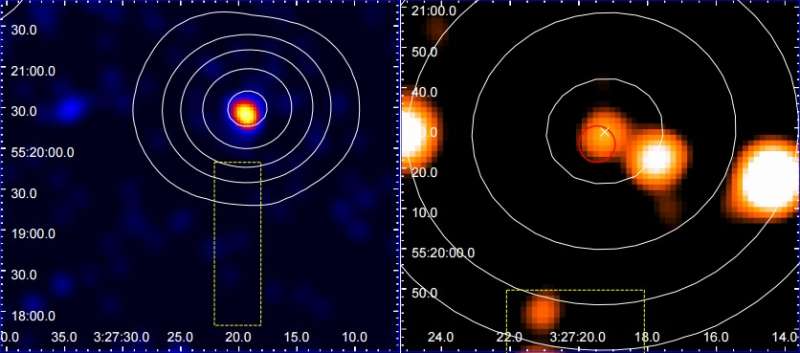September 28, 2016 report
Scientists investigate unidentified radio sources

(Phys.org)—A team of researchers led by Andrea Maselli of the Institute of Space Astrophysics and Cosmic Physics of Palermo, Italy, has conducted an observational campaign of a group of unassociated radio sources with NASA's Swift space observatory. The observations were aimed at revealing the true nature of these so far unidentified sources. The results were published Sept. 23 in a paper on arXiv.org.
The Swift spacecraft, scanning the universe in the gamma-ray, X-ray, ultraviolet, and optical wavebands, is an invaluable tool when it comes to studying gamma-ray bursts and other electromagnetic events. It has already proved its scientific importance in many ways, for example by performing the first sensitive hard X-ray survey of the sky.
Recently, Maselli and his team employed Swift to observe 21 bright radio sources included in the revised Third Cambridge Catalogue (3CR) of radio sources. The catalog contains celestial radio sources detected at 178 MHz that could advance our knowledge about the nature and evolution of powerful radio galaxies and quasars.
However, some sources described in the 3CR catalog, including these detected by the NRAO VLA Sky Survey (NVSS), are not only unobserved in X-rays, but are, in fact, completely unidentified, lacking an assigned optical or infrared counterpart. The authors of the paper decided to fill this gap by conducting a supplementary optical-to-X-ray campaign with the Swift spacecraft, in order to better characterize the properties of these unidentified sources.
"We have investigated a group of unassociated radio sources included in the 3CR catalog to increase the multi-frequency information on them and possibly obtain an identification," the researchers wrote in the paper.
Each of the 21 sources was observed by two telescopes onboard Swift – the X-ray Telescope (XRT) and the Ultraviolet/Optical Telescope (UVOT). The observation campaign lasted from November 2014 to March 2015.
According to the research, out of these 21 investigated sources, nine exhibit significant emission in the soft X-ray band. The scientists managed to assign an infrared counterpart in the AllWISE (All Wide-field Infrared Survey Explorer) catalog for these nine sources and in four cases with no soft X-ray association.
"After conducting Swift observations of 21 bright NVSS sources corresponding to 3CR sources classified as unassociated in the third update of the 3CR catalogue, we have obtained new X-ray detections for nine of them. Moreover, cross-matching the NVSS with the recent AllWISE Catalogue, we have found a WISE counterpart to all these nine X-ray sources, as well as to four cases with no X-ray detection," the paper reads.
What baffled the researchers is that no optical/UV counterpart has been found by UVOT, what lead them to an assumption that these unidentified radio sources should be classified as obscured active galaxies. However, the team added that it is too early to draw final conclusions as spectroscopic observations are needed to confirm this hypothesis.
"Our analysis suggests that a spectroscopic analysis in the infrared range will be more helpful to identify their nature as well as potentially obtain a redshift measurement," the team wrote.
More information: A. Maselli et al. observations of unidentified radio sources in the revised Third Cambridge Catalogue, Monthly Notices of the Royal Astronomical Society (2016). DOI: 10.1093/mnras/stw1222 , Arxiv: arxiv.org/abs/1609.07484
Abstract
We have investigated a group of unassociated radio sources included in the 3CR cat- alogue to increase the multi-frequency information on them and possibly obtain an identification. We have carried out an observational campaign with the Swift satellite to observe with the UVOT and the XRT telescopes the field of view of 21 bright NVSS sources within the positional uncertainty region of the 3CR sources. Furthermore, we have searched in the recent AllWISE Source Catalogue for infrared sources matching the position of these NVSS sources. We have detected significant emission in the soft X-ray band for nine of the investigated NVSS sources. To all of them, and in four cases with no soft X-ray association, we have associated a WISE infrared counterpart. Eight of these infrared candidates have not been proposed earlier in the literature. In the five remaining cases our candidate matches one among a few optical candidates suggested for the same 3CR source in previous studies. No source has been detected in the UVOT filters at the position of the NVSS objects, confirming the scenario that all of them are heavily obscured. With this in mind, a spectroscopic campaign, preferably in the infrared band, will be necessary to establish the nature of the sources that we have finally identified.
Journal information: Monthly Notices of the Royal Astronomical Society , arXiv
© 2016 Phys.org





















